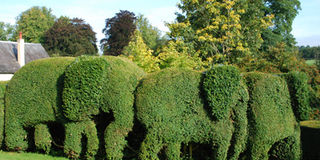Setting up a natural hedge

A natural hedge allows you to express yourself creatively while conserving the environment by planting trees.
Traditionally used as boundary markers, natural hedges are increasingly being used to as perimeter fences while adding something new to the landscape design. Natural hedges are not only cheap, easy to plant and but they also help in conserving the environment.
Plant hedges are a great way to supplement a wire or railing fence to create privacy for your home. Morris Mukisa, a landscape designer, notes that natural hedges give a home a more luxurious and contemporary look.
“Tall growing grasses or mature trees, for instance on a perimeter fence do not only have a positive aesthetic effect but cancel noise and help reduce the amount of dust exposed to the home,” he notes.
Choosing plants
When choosing plants Mukisa recommends slow-growing species that have foliage all year-round or at least most of the time and are easy to maintain.
“You need plants that grow to a height that can be easily accessible for pruning, so you will look for those that grow outward instead of upwards,” he advises.
Hedge plants should be about 60cm (2ft) high; they are cheap and are easy to plant. To supplement your small plants, you will need larger ones that tend to be more expensive and need more care.
The landscape designer says planting a mix of small and large plants does not only enable them to form a thick fence but controls their growth since they compete for the same nutrients and so reduce the amount of trimming required.
Brenda Ekky, a florist, recommends paper gardenia a large evergreen shrub that produces waxy, pure, white, ruffle-edged flowers which give off a beautiful fragrance at night.
“This beautiful plant is perfect for a new hedge because it grows fast and will help you create structure and form,” she relates. Ekky also recommends the Oleander, an evergreen shrub (or small tree) that grows to approximately six metres.
The leaves are usually in groups of three while the flowers are tubular with five lobes. The tree produces red, pink white, cream, yellow or purple flowers that sometimes give off a beautiful scent.
“The shrub should, however, be handled with care as it is poisonous,” she warns.
For climbers, Ekky recommends the breath-taking bougainvillea plant. “The bougainvillea tends to grow wild so it needs regular pruning and training,” she says.
It is advisable to add thorny plants such as the Natal plum which is famed for its ferocious spines that help block even the bravest intruder. The plant also has glossy green foliage and fragrant white flowers and can withstand long drought.
Others include bamboo, yew, griselinia, camellias, English laurel and grasses such as Miscanthus Strictus, Karley rose and the maiden grass, among others.
When to plant a hedge
The ideal time to plant your new hedge is during the wet season when the ground is moist enough for the roots to take root.
Before planting, it is important to prepare the ground by weeding and adding fertiliser if need be. If you need privacy fast plant more mature plants to start with.
Hedge plants are usually sold as either bare root or container grown. While they have the same quality the container grown is a better option for a mature hedge.
Planting
Ideally position boundary hedges so they are set back a little way (e.g. 90cm/3ft) from the boundary line. This will allow the hedge to fill out before it becomes an issue with overhanging the pavement or a neighbour’s property.
Within the row planting distances vary from 30-60cm (1-2ft), depending on the plants’ final size, the size of hedge required and plant vigour. For hedges thicker than 90cm (3ft), plant a staggered double row 45cm (18in) apart, with plants 90cm (3ft) apart.
Trim back damaged roots to healthy growth with sharp knife or old pair of secateurs
Spread out the roots, ensuring the planting depth is correct. The point where the roots flare out from the stem should be level with the surrounding soil; on container-grown plants, scrape away the compost from the top of the root ball to reveal this point.
On sandy or heavy clay soils, mix organic matter, such as garden compost or a proprietary tree and shrub planting mix, with the soil dug out from the hole to backfill. Alternatively, spread over the soil surface and mix into the top 25cm (10in) of soil with a fork (forking in)
Work soil between the roots, firm plants in so that soil is in close contact with the roots. Water if the soil is dry
Mulch to a depth of 7.5cm (3in) after planting to prevent weeds.
Problems
Hedges might take three to seven years to attain their desired size. You can buy semi-mature hedges which, although costly, will give an instant hedge. Semi-mature plants require extra care in planting and watering.




